Related Research Articles

The Fairey Firefly is a Second World War-era carrier-borne fighter aircraft and anti-submarine aircraft that was principally operated by the Fleet Air Arm (FAA). It was developed and built by the British aircraft manufacturer Fairey Aviation Company.

The Fairey Fox was a British light bomber and fighter biplane of the 1920s and 1930s. It was originally produced in Britain for the RAF, but continued in production and use in Belgium long after it was retired in Britain.

The Curtiss XP-46 was a 1940s American prototype fighter aircraft. It was a development of the Curtiss-Wright Corporation in an effort to introduce the best features found in European fighter aircraft in 1939 into a fighter aircraft which could succeed the Curtiss P-40, then in production.

The Curtiss P-60 was a 1940s American single-engine single-seat, low-wing monoplane fighter aircraft developed by the Curtiss-Wright company as a successor to its P-40. It went through a lengthy series of prototype versions, eventually evolving into a design that bore little resemblance to the P-40. None of these versions reached production.

The Hawker Hornbill was the last Hawker military aircraft designed under the direction of George Carter. The design was started in 1925 and the first flight took place in July 1925. The Hornbill did not achieve service in the Royal Air Force due to problems in its power plant and radiator. Only one aircraft was built.
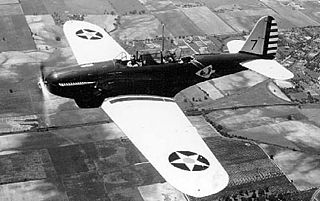
The Consolidated P-30 (PB-2) was a 1930s United States two-seat fighter aircraft. An attack version called the A-11 was also built, along with 2 Y1P-25 prototypes and YP-27, Y1P-28, and XP-33 proposals. The P-30 is significant for being the first fighter in United States Army Air Corps service to have retractable landing gear, an enclosed and heated cockpit for the pilot, and an exhaust-driven turbo-supercharger for altitude operation.

The Curtiss F7C Seahawk was a carrier-capable biplane fighter aircraft of the United States Navy Marine Corps in the late 1920s and early 1930s.
The Fairey P.4/34 was a competitor for an order for a light bomber to serve with the Royal Air Force. Although not produced in that form, it formed the basis for the Fulmar long-range carrier-based fighter for the Fleet Air Arm.

The Fairey Firefly IIM was a British fighter of the 1930s. It was a single-seat, single-engine biplane of all-metal construction. Built by Fairey Aviation Company Limited, it served principally with the Belgian Air Force throughout the 1930s until the outbreak of World War II.

The Avro 566 Avenger was a prototype British fighter of the 1920s, designed and built by Avro. It was a single-seat, single-engine biplane of wood and fabric construction. Although it was a streamlined and advanced design, it never entered production.
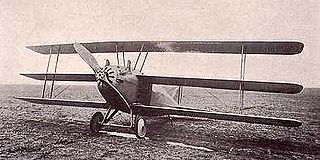
The Curtiss 18T, unofficially known as the Wasp and by the United States Navy as the Kirkham, was an early American triplane fighter aircraft designed by Curtiss for the US Navy.

The Nightjar was a British carrier-based fighter aircraft of the early 1920s. It was a modification of the earlier Nieuport Nighthawk fighter produced by Gloster after the Nieuport & General company, which designed the Nighthawk, closed down. Twenty-two were converted, serving with the British Royal Air Force from 1922 to 1924.

The Parnall Plover was a British single-seat naval fighter aircraft of the 1920s. Designed and built by George Parnall & Co. for use on Royal Navy aircraft carriers, it was ordered into small-scale production but after extensive evaluation, the Fairey Flycatcher was preferred for large-scale service.

The Curtiss XP-22 Hawk was a 1930s American experimental biplane fighter built by Curtiss for evaluation by the United States Army Air Service.
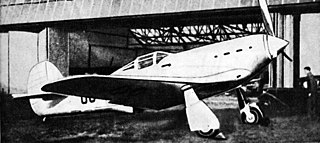
The Renard R.36 was a Belgian all-metal fighter aircraft designed by Alfred Renard to replace the Fairey Firefly IIM within the Belgian Air Force. Designed to improve on the Renard Epervier, which was never adopted by the Belgian government, the prototype R.36 first flew on 5 November 1937. Following testing the R.36 was selected by the Belgian Air Force in late 1938, with 40 aircraft provisionally ordered, to be delivered in two years.

The Fairey Fantôme, also known as the Fairey Féroce, was a Belgian fighter prototype of the mid-1930s. The prototype was designed and built by Fairey Aviation and three production aircraft were assembled in Belgium by Avions Fairey.
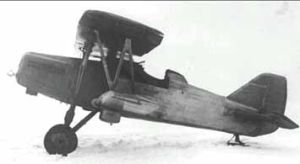
The Tupolev I-8 was an experimental interceptor built in the Soviet Union in the early 1930s.

The Laville DI-4 was a prototype two-seat fighter aircraft developed in the Soviet Union in the 1930s. The chief designer Henri Laville was one of several French aviation specialists invited to work in the Soviet Union and not surprisingly the DI-4 layout was typical of the French trend at the time with the first high-mounted gull wing on a Soviet aircraft and all-metal construction.

The Fairey Fleetwing was a British two-seat, single-engine biplane designed to an Air Ministry contract for carrier-based reconnaissance operations in the late 1920s. Only one was built.
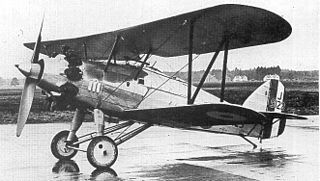
The Hawker F.20/27 was a British fighter design built to an Air Ministry specification for an interceptor in the late 1920s. It was a single-seat biplane powered by a radial engine; the very similar but V-12-engined Hawker Fury development proved superior and only one F.20/27 was built.
References
- 1 2 Mason, Francis K (1992). The British Fighter since 1912. Naval Institute Press. ISBN 1-55750-082-7.
- 1 2 Green, W; Swanborough, G (1994). The Complete Book of Fighters. Smithmark. ISBN 0-8317-3939-8.